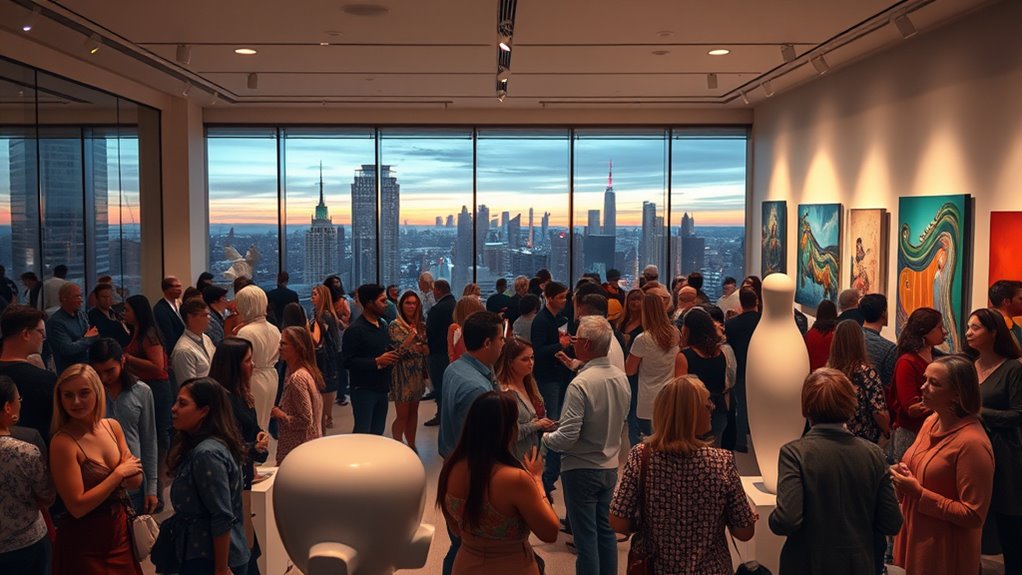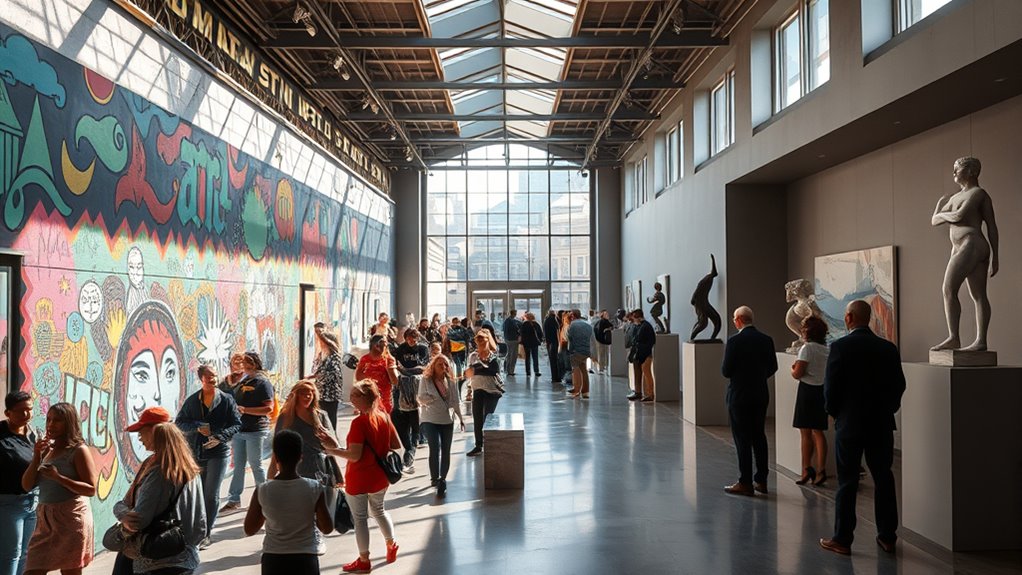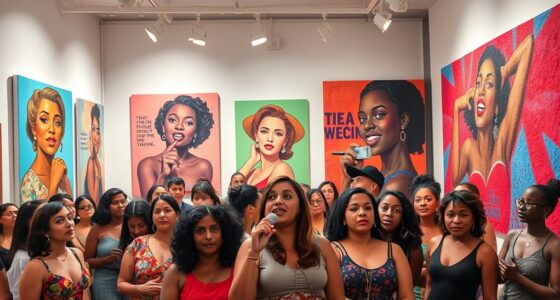Public funding helps safeguard cultural heritage, guarantees inclusive access, and supports community-driven art projects that reflect societal values. Private support often focuses on innovation, commercialization, and large-scale exhibitions that boost visibility and economic growth. Both sources work together to strengthen cultural identity, stimulate local economies, and foster community pride. Exploring how these funding streams complement each other reveals the true impact of art in society and why understanding their roles matters more than ever.
Key Takeaways
- Public funding promotes inclusivity, cultural preservation, and access for diverse communities, reflecting societal values and heritage.
- Private support often targets innovative projects, festivals, and commercialization, shaping broader perceptions of cultural identities.
- Both funding sources together enhance cultural vibrancy, economic growth, and community resilience through complementary roles.
- Public investment sustains local art initiatives and preserves cultural identities, while private sponsorship drives large-scale projects and innovation.
- The synergy between public and private art funding benefits society by fostering cultural diversity, economic development, and community engagement.

Have you ever wondered how art funding shapes society? When you consider the role of public and private support, it’s clear that funding influences not just individual artists but the very fabric of communities. One of the most significant ways funding impacts society is through cultural identity. Art acts as a mirror, reflecting the history, values, and stories of a community. When public funds support local art initiatives, they help preserve and promote unique cultural expressions that might otherwise fade away. This kind of backing guarantees that diverse voices are heard, fostering a sense of belonging and pride among community members. Private support, on the other hand, often channels into more targeted projects, which can both celebrate and commercialize cultural identities, shaping perceptions on a broader scale. Both forms of funding serve to reinforce cultural roots, but public funding tends to prioritize inclusivity and heritage, while private support might focus on innovation or individual achievement.
Beyond cultural identity, art funding has a tangible economic impact that directly affects your community. When governments allocate funds for the arts, they often stimulate local economies by creating jobs, attracting tourism, and encouraging investment in creative industries. Museums, theaters, and galleries become economic hubs, drawing visitors who spend money on tickets, dining, and accommodations. Private sponsors, meanwhile, may invest in large-scale projects or festivals that bring visitors and media attention, further boosting economic activity. These investments pay off by increasing foot traffic and consumer spending, which benefits small businesses and local entrepreneurs. Additionally, supporting the arts can lead to long-term economic growth by nurturing creative talent that may develop into thriving industries, such as design, media, or technology, which are increasingly crucial to modern economies. When public and private funding align, they amplify this impact, ensuring the arts remain a catalyst for both cultural vibrancy and economic vitality. Moreover, recognizing the importance of comprehensive support from diverse sources can maximize the positive effects on society.
In essence, your society’s cultural identity and economic health are deeply intertwined with the way art is funded. Public support helps safeguard cultural heritage and ensures broad access, fostering a sense of shared identity. Private backing fuels innovation, growth, and the expansion of artistic horizons, often bringing fresh perspectives and resources. Both sources are essential, and their interplay shapes a resilient, dynamic society that values its cultural roots while embracing progress. So, whether you’re an artist, a supporter, or simply a community member, understanding how these funding streams work reveals how deeply art influences your everyday life and the future of your community.
Frequently Asked Questions
How Do Public and Private Funding Impact Artistic Diversity?
Public and private funding shape artistic diversity by influencing cultural representation and fostering artistic innovation. When public funds prioritize inclusive policies, you see a broader range of cultural voices, promoting diversity. Private support often drives innovation through grants for experimental projects, but may favor popular or marketable art. Together, they can expand or limit artistic diversity, depending on how funding priorities align with diverse cultural expressions and innovative practices.
What Are the Long-Term Effects of Government Arts Grants?
You might be surprised to learn that government arts grants have helped preserve over 60% of endangered cultural sites. In the long run, these grants foster cultural preservation and encourage artistic innovation, ensuring diverse voices thrive. They provide stability, allowing artists to experiment and push boundaries without fear of financial failure. Ultimately, government support nurtures a vibrant, inclusive arts landscape that benefits society for generations.
How Do Private Donors Influence Art Content and Themes?
Private donors can considerably influence art content and themes through their donations, often shaping artistic independence. You might find that artists or institutions alter their work to align with donor interests, risking a loss of creative freedom. Donor influence can steer art toward specific messages or styles, potentially limiting diverse perspectives. To maintain artistic independence, it’s essential to establish clear boundaries that prevent donor influence from overriding artistic integrity.
What Role Do Corporate Sponsors Play in Art Accessibility?
Corporate sponsors play a significant role in art accessibility by providing funding that helps galleries and exhibitions reach wider audiences. However, you should be aware of corporate influence and sponsorship ethics, which can shape the themes and presentations of art. While their support increases accessibility, it’s essential to take into account how corporate interests might sway artistic expression or limit certain viewpoints, ensuring transparency and integrity in the process.
How Can Society Ensure Equitable Art Funding Distribution?
You can guarantee equitable art funding distribution by promoting community engagement and demanding funding transparency. Engage local communities to identify diverse artistic needs and priorities. Push for open, transparent processes that allow public scrutiny and accountability. Support policies that allocate resources fairly, ensuring underserved groups receive attention. By actively participating in these efforts, you help create an inclusive art landscape where every voice matters and resources reach those who need them most.
Conclusion
Ultimately, whether you lean on public or private support, remember that art is the heartbeat of society’s soul. Like a bridge connecting communities, funding shapes the cultural landscape we all cherish. Your role in supporting art—through choice or advocacy—keeps this vibrant tapestry alive. So, embrace your part in nurturing creativity, for when society invests in art, it’s like planting seeds that blossom into a richer, more colorful world for everyone to enjoy.










